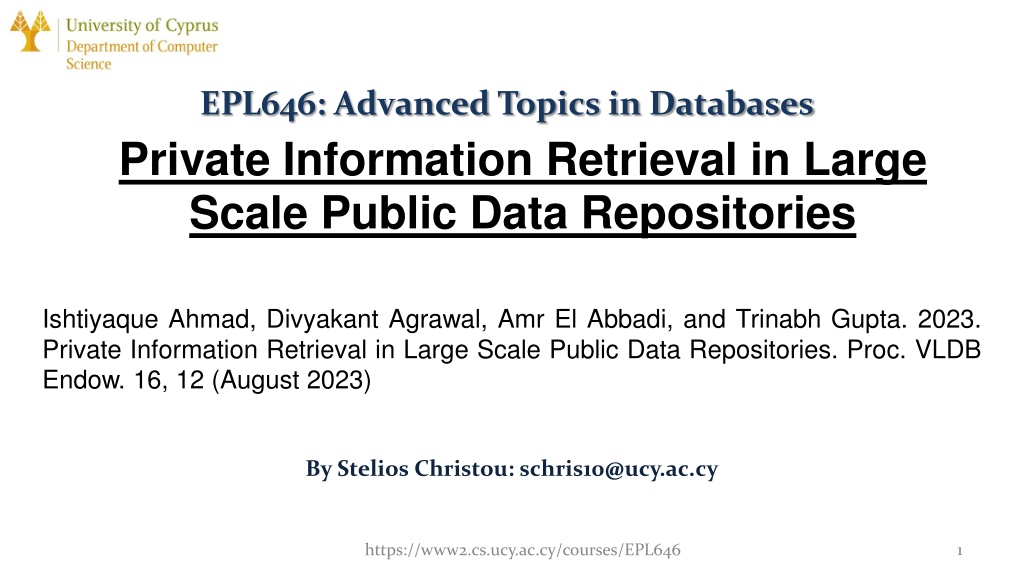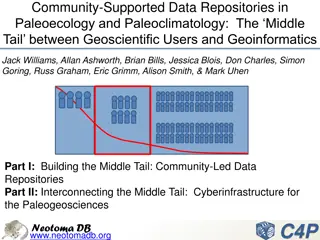Private Information Retrieval in Large-Scale Data Repositories
Private Information Retrieval (PIR) is a protocol that allows clients to retrieve data privately without revealing the query or returned data to the server or anyone spying on the network. Encrypting data on the server is not a solution due to security concerns related to server ownership. This advanced database topic is crucial as more data moves to the cloud, emphasizing the importance of privacy and security in data retrieval.
Uploaded on Oct 04, 2024 | 0 Views
Download Presentation

Please find below an Image/Link to download the presentation.
The content on the website is provided AS IS for your information and personal use only. It may not be sold, licensed, or shared on other websites without obtaining consent from the author. Download presentation by click this link. If you encounter any issues during the download, it is possible that the publisher has removed the file from their server.
E N D
Presentation Transcript
EPL646: Advanced Topics in Databases Private Information Retrieval in Large Scale Public Data Repositories Ishtiyaque Ahmad, Divyakant Agrawal, Amr El Abbadi, and Trinabh Gupta. 2023. Private Information Retrieval in Large Scale Public Data Repositories. Proc. VLDB Endow. 16, 12 (August 2023) By Stelios Christou: schris10@ucy.ac.cy 1 https://www2.cs.ucy.ac.cy/courses/EPL646
What is Private Information Retrieval (PIR) A protocol that allows clients to privately retrieve data, without anyone knowing the executed query or the data returned The server, the network and anyone spying on the network should not know or be able to figure out this information This is very useful as data has now moved to cloud
What is Private Information Retrieval (PIR) A protocol that allows clients to privately retrieve data, without anyone knowing the executed query or the data returned The server, the network and anyone spying on the network should not know or be able to figure out this information This is very useful as data has now moved to cloud
What is Private Information Retrieval (PIR) A protocol that allows clients to privately retrieve data, without anyone knowing the executed query or the data returned The server, the network and anyone spying on the network should not know or be able to figure out this information This is very useful as data has now moved to cloud
No Why? We don t own the server Security concerns
No Why? We don t own the server Security concerns
Basic Outline Server has data stored in array A, size of n Client wants to retrieve data A[i] Client sends query q to server Server returns response r to client Client receives r
PIR Protocol Outline Server has data stored in array A, size of n Client wants to retrieve data A[i] Client sends encrypted query q to server Server returns encrypted response r to client Client receives encrypted r Client decrypts r
PIR Protocol Must Guarantee Correctness Privacy
PIR Categories Information Theoretic PIR (IT-PIR) Array is replicated in multiple servers Each server sends differ part of r Client puts together the parts to get r Servers must not communicate with each other! Hard to achieve
PIR Categories Computational PIR (CPIR) Array is stored in a single server Server computes r Client receives r All of this is done with encrypted data!
CPIR - Homomorphic Encryption Allows for encrypted data computation without the need of decryption Uses two keys. Secret Key sk, Public Key pk Encrypt (v, pk): Encrypts message v using pk. Encrypted message is a ciphertext c and its size is bigger than the size of v Decrypt (c, sk): Decrypts ciphertext c using sk. Decrypted message is the original message v Add (c1, c2): Adds the two ciphertexts (c1+c2) and gives the encryption of (v1+v2) Multiply (c1, c2): Multiplies the two ciphertexts (c1*c2) and gives the encryption of (v1*v2) MultiplyPlain (v1, c2): Same as Multiply but using one cipher and one plain text
CPIR - How Does it Work (Client Query) Generates sk and pk Creates query of size n which includes values of 0 and 1 If digit i is 1, it means that the client wants to receive the data positioned at A[i] If digit i is 0, it means that the client doesn t care for the data at that index Encrypts q using Encrypt (q, pk) and sends it to server
CPIR - How Does it Work (Server) Receives encrypted q Performs MultiplyPlain between q[i] and A[i] Performs Add for every multiplication q[i]*A[i] to generate r Returns r to client
CPIR - How Does it Work (Client Response) Receives r Decrypts r using Decrypt (r, sk)
CPIR - Performance Size of q. Bigger means more execution time Computation time to generate r. Bigger means more execution time Size of r. Bigger means more execution time Each affects the other! Hard to improve performance
CPIR - Performance Multi-dimensional arrays Arrange q and A to Higher dimensions Compute response for 2 smaller queries
CPIR - Performance Multi-dimensional arrays Smaller queries, bigger response size r gets bigger with every encryption
Retrieving Multiple Elements Batch Code (method similar to HashMap) Database records are split to groups and each group is assigned a code Codes are distributed in buckets Queries are encoded to a ser of codes Server returns corresponding groups based on query codes
Real Life Application Clients don t usually know index i Multiple element retrieval is applied first Client picks desired result Data is retrieved based on client s choice
What if the server doesnt save data in an array structure?
Key - Value Retrieval Data is saved in pairs of <key, value> Client probably know the key and not the index!
PIR Protocol Extension Keys are arranged in a binary tree Phase 1: Search tree to find index based on key using Breadth First Search Phase 2: Retrieve data based on index
PIR Protocol Extension Keys are arranged in a binary tree Phase 1: Search tree to find index based on key using Breadth First Search Phase 2: Retrieve data based on index Very time consuming for large amount of data! What if data changes between the two phases?
Single Round Value Retrieval Client sends encrypted key Server performs equality checks to find the key If equal return encrypted 1 If not equal, return encrypted 0 Builds an encrypted query q, like before
Conclusion Private Information Retrieval is possible Research required to improve performance Research required to apply on SQL queries and other types of queries
References [Paper] Ishtiyaque Ahmad, Divyakant Agrawal, Amr El Abbadi, and Trinabh Gupta. 2023. Private Information Retrieval in Large Scale Public Data Repositories. Proc. VLDB Endow. 16, 12 (August 2023), 3868 3871. [Tutorial] https://sites.cs.ucsb.edu/~ishtiyaque/files/VLDB_2023_Tutorial.pdf



























